Organisational Behaviour Report: Hays Travel Analysis
VerifiedAdded on 2023/01/09
|16
|5223
|74
Report
AI Summary
This report provides a comprehensive analysis of organisational behaviour principles, specifically examining their application within Hays Travel. The report begins with a critical analysis of culture, power, and politics and their impact on performance, incorporating Handy's model of culture and French and Raven's power model. It then delves into motivation, exploring various theories including Maslow's hierarchy of needs and Adam's equity theory. The report also examines the relationship between culture, power, politics, and motivation. The second part of the report focuses on the importance of teamwork within Hays Travel, differentiating between effective and ineffective teams. Finally, it discusses team development theories. The report aims to provide insights into how these elements contribute to the overall performance and success of the organisation.
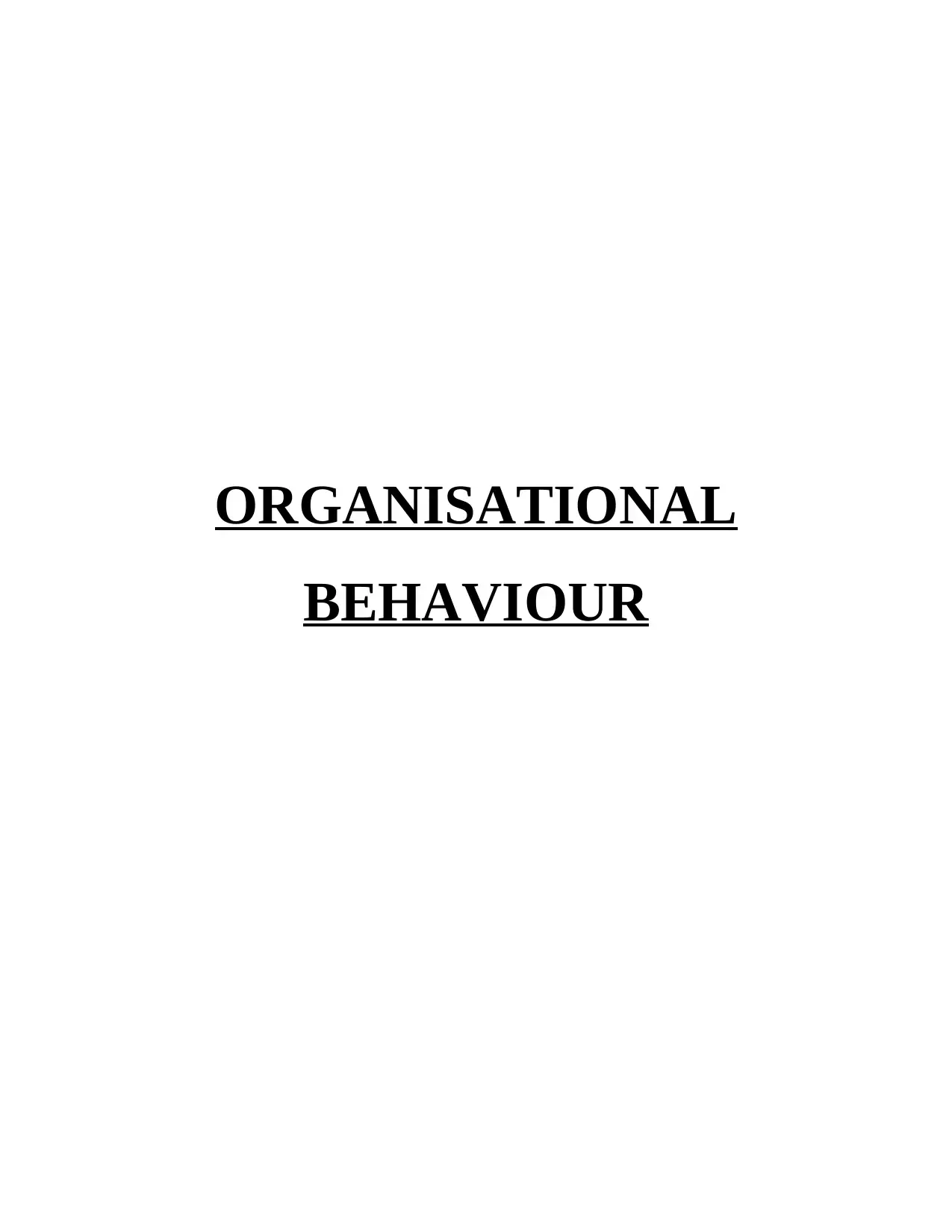
ORGANISATIONAL
BEHAVIOUR
BEHAVIOUR
Paraphrase This Document
Need a fresh take? Get an instant paraphrase of this document with our AI Paraphraser
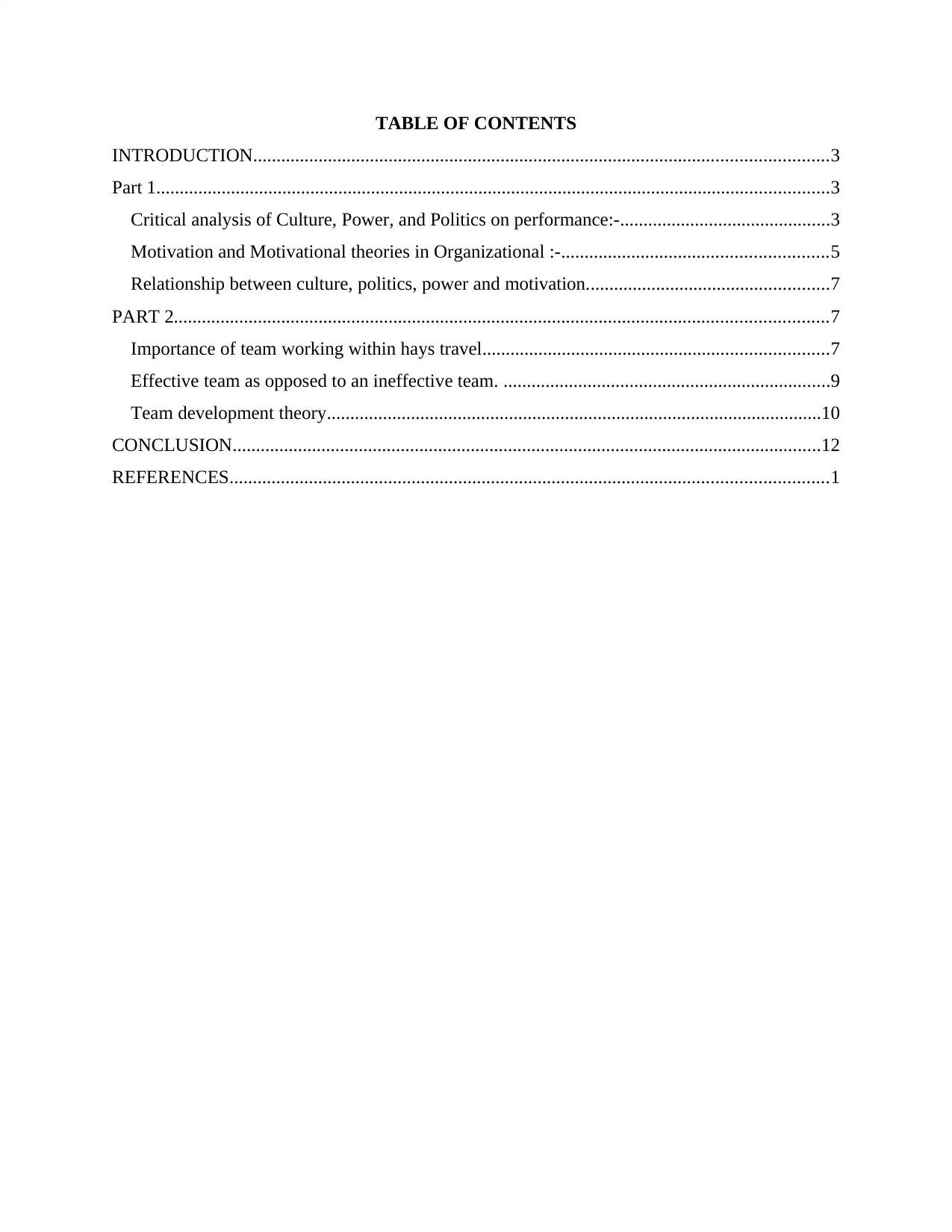
TABLE OF CONTENTS
INTRODUCTION...........................................................................................................................3
Part 1................................................................................................................................................3
Critical analysis of Culture, Power, and Politics on performance:-.............................................3
Motivation and Motivational theories in Organizational :-.........................................................5
Relationship between culture, politics, power and motivation....................................................7
PART 2............................................................................................................................................7
Importance of team working within hays travel..........................................................................7
Effective team as opposed to an ineffective team. ......................................................................9
Team development theory..........................................................................................................10
CONCLUSION..............................................................................................................................12
REFERENCES................................................................................................................................1
INTRODUCTION...........................................................................................................................3
Part 1................................................................................................................................................3
Critical analysis of Culture, Power, and Politics on performance:-.............................................3
Motivation and Motivational theories in Organizational :-.........................................................5
Relationship between culture, politics, power and motivation....................................................7
PART 2............................................................................................................................................7
Importance of team working within hays travel..........................................................................7
Effective team as opposed to an ineffective team. ......................................................................9
Team development theory..........................................................................................................10
CONCLUSION..............................................................................................................................12
REFERENCES................................................................................................................................1
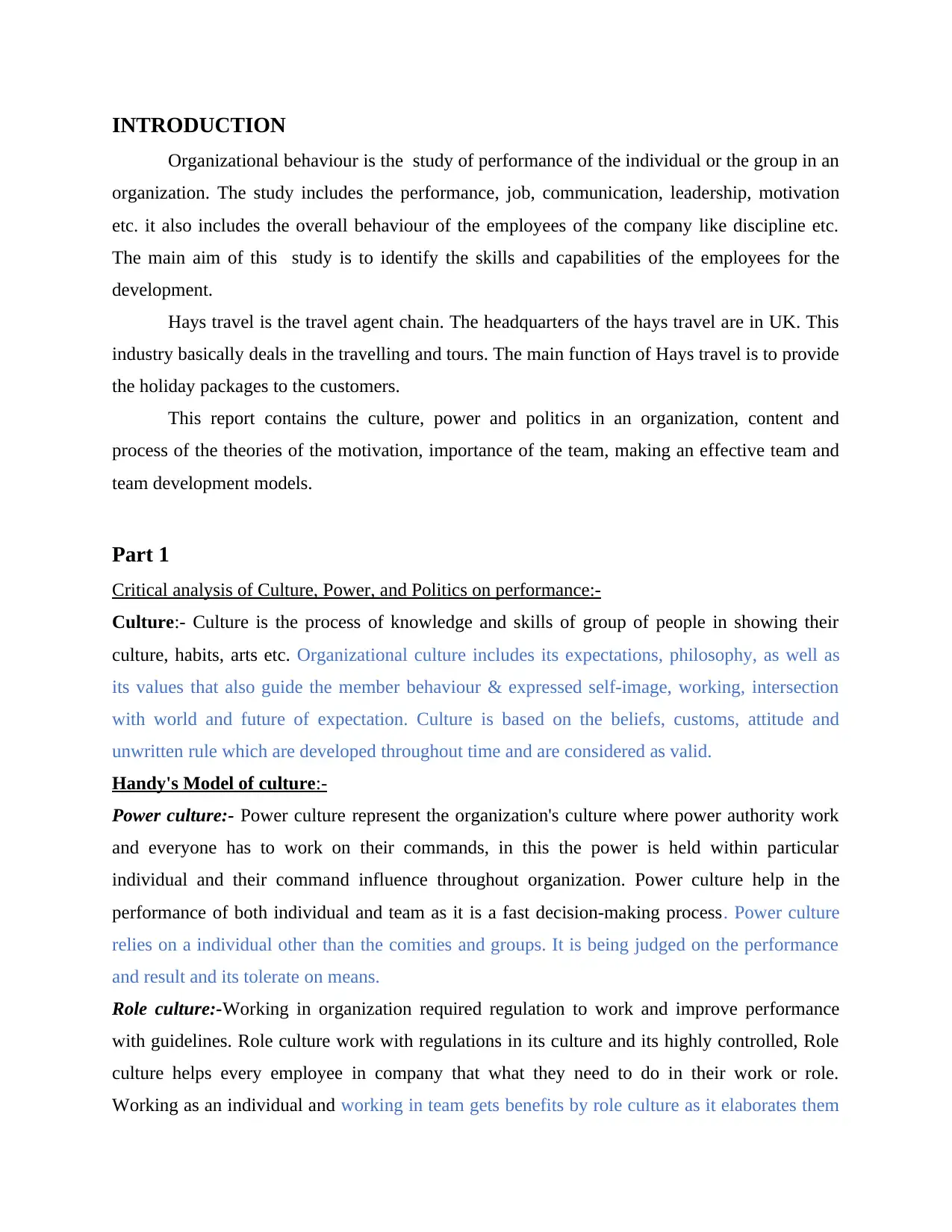
INTRODUCTION
Organizational behaviour is the study of performance of the individual or the group in an
organization. The study includes the performance, job, communication, leadership, motivation
etc. it also includes the overall behaviour of the employees of the company like discipline etc.
The main aim of this study is to identify the skills and capabilities of the employees for the
development.
Hays travel is the travel agent chain. The headquarters of the hays travel are in UK. This
industry basically deals in the travelling and tours. The main function of Hays travel is to provide
the holiday packages to the customers.
This report contains the culture, power and politics in an organization, content and
process of the theories of the motivation, importance of the team, making an effective team and
team development models.
Part 1
Critical analysis of Culture, Power, and Politics on performance:-
Culture:- Culture is the process of knowledge and skills of group of people in showing their
culture, habits, arts etc. Organizational culture includes its expectations, philosophy, as well as
its values that also guide the member behaviour & expressed self-image, working, intersection
with world and future of expectation. Culture is based on the beliefs, customs, attitude and
unwritten rule which are developed throughout time and are considered as valid.
Handy's Model of culture:-
Power culture:- Power culture represent the organization's culture where power authority work
and everyone has to work on their commands, in this the power is held within particular
individual and their command influence throughout organization. Power culture help in the
performance of both individual and team as it is a fast decision-making process. Power culture
relies on a individual other than the comities and groups. It is being judged on the performance
and result and its tolerate on means.
Role culture:-Working in organization required regulation to work and improve performance
with guidelines. Role culture work with regulations in its culture and its highly controlled, Role
culture helps every employee in company that what they need to do in their work or role.
Working as an individual and working in team gets benefits by role culture as it elaborates them
Organizational behaviour is the study of performance of the individual or the group in an
organization. The study includes the performance, job, communication, leadership, motivation
etc. it also includes the overall behaviour of the employees of the company like discipline etc.
The main aim of this study is to identify the skills and capabilities of the employees for the
development.
Hays travel is the travel agent chain. The headquarters of the hays travel are in UK. This
industry basically deals in the travelling and tours. The main function of Hays travel is to provide
the holiday packages to the customers.
This report contains the culture, power and politics in an organization, content and
process of the theories of the motivation, importance of the team, making an effective team and
team development models.
Part 1
Critical analysis of Culture, Power, and Politics on performance:-
Culture:- Culture is the process of knowledge and skills of group of people in showing their
culture, habits, arts etc. Organizational culture includes its expectations, philosophy, as well as
its values that also guide the member behaviour & expressed self-image, working, intersection
with world and future of expectation. Culture is based on the beliefs, customs, attitude and
unwritten rule which are developed throughout time and are considered as valid.
Handy's Model of culture:-
Power culture:- Power culture represent the organization's culture where power authority work
and everyone has to work on their commands, in this the power is held within particular
individual and their command influence throughout organization. Power culture help in the
performance of both individual and team as it is a fast decision-making process. Power culture
relies on a individual other than the comities and groups. It is being judged on the performance
and result and its tolerate on means.
Role culture:-Working in organization required regulation to work and improve performance
with guidelines. Role culture work with regulations in its culture and its highly controlled, Role
culture helps every employee in company that what they need to do in their work or role.
Working as an individual and working in team gets benefits by role culture as it elaborates them
⊘ This is a preview!⊘
Do you want full access?
Subscribe today to unlock all pages.

Trusted by 1+ million students worldwide
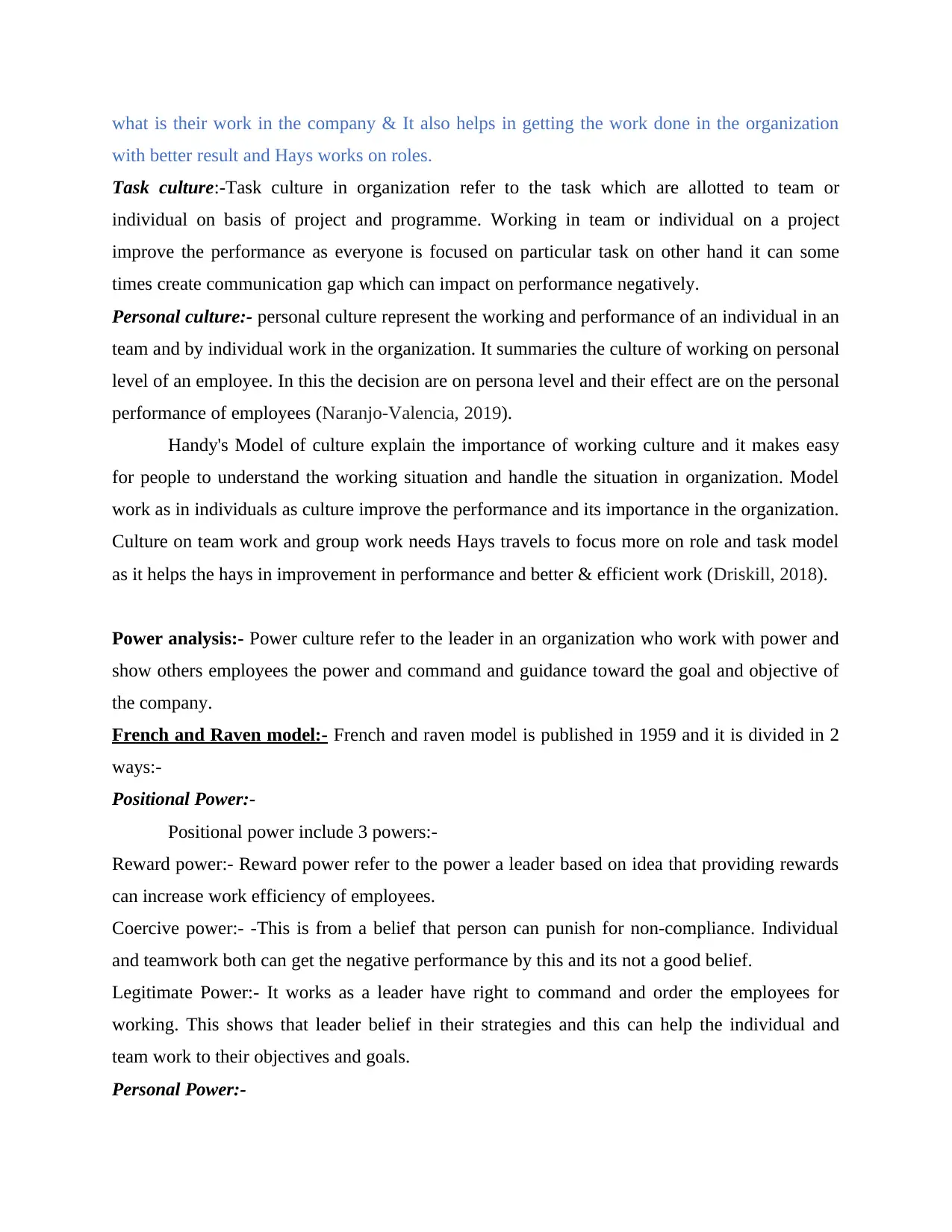
what is their work in the company & It also helps in getting the work done in the organization
with better result and Hays works on roles.
Task culture:-Task culture in organization refer to the task which are allotted to team or
individual on basis of project and programme. Working in team or individual on a project
improve the performance as everyone is focused on particular task on other hand it can some
times create communication gap which can impact on performance negatively.
Personal culture:- personal culture represent the working and performance of an individual in an
team and by individual work in the organization. It summaries the culture of working on personal
level of an employee. In this the decision are on persona level and their effect are on the personal
performance of employees (Naranjo-Valencia, 2019).
Handy's Model of culture explain the importance of working culture and it makes easy
for people to understand the working situation and handle the situation in organization. Model
work as in individuals as culture improve the performance and its importance in the organization.
Culture on team work and group work needs Hays travels to focus more on role and task model
as it helps the hays in improvement in performance and better & efficient work (Driskill, 2018).
Power analysis:- Power culture refer to the leader in an organization who work with power and
show others employees the power and command and guidance toward the goal and objective of
the company.
French and Raven model:- French and raven model is published in 1959 and it is divided in 2
ways:-
Positional Power:-
Positional power include 3 powers:-
Reward power:- Reward power refer to the power a leader based on idea that providing rewards
can increase work efficiency of employees.
Coercive power:- -This is from a belief that person can punish for non-compliance. Individual
and teamwork both can get the negative performance by this and its not a good belief.
Legitimate Power:- It works as a leader have right to command and order the employees for
working. This shows that leader belief in their strategies and this can help the individual and
team work to their objectives and goals.
Personal Power:-
with better result and Hays works on roles.
Task culture:-Task culture in organization refer to the task which are allotted to team or
individual on basis of project and programme. Working in team or individual on a project
improve the performance as everyone is focused on particular task on other hand it can some
times create communication gap which can impact on performance negatively.
Personal culture:- personal culture represent the working and performance of an individual in an
team and by individual work in the organization. It summaries the culture of working on personal
level of an employee. In this the decision are on persona level and their effect are on the personal
performance of employees (Naranjo-Valencia, 2019).
Handy's Model of culture explain the importance of working culture and it makes easy
for people to understand the working situation and handle the situation in organization. Model
work as in individuals as culture improve the performance and its importance in the organization.
Culture on team work and group work needs Hays travels to focus more on role and task model
as it helps the hays in improvement in performance and better & efficient work (Driskill, 2018).
Power analysis:- Power culture refer to the leader in an organization who work with power and
show others employees the power and command and guidance toward the goal and objective of
the company.
French and Raven model:- French and raven model is published in 1959 and it is divided in 2
ways:-
Positional Power:-
Positional power include 3 powers:-
Reward power:- Reward power refer to the power a leader based on idea that providing rewards
can increase work efficiency of employees.
Coercive power:- -This is from a belief that person can punish for non-compliance. Individual
and teamwork both can get the negative performance by this and its not a good belief.
Legitimate Power:- It works as a leader have right to command and order the employees for
working. This shows that leader belief in their strategies and this can help the individual and
team work to their objectives and goals.
Personal Power:-
Paraphrase This Document
Need a fresh take? Get an instant paraphrase of this document with our AI Paraphraser
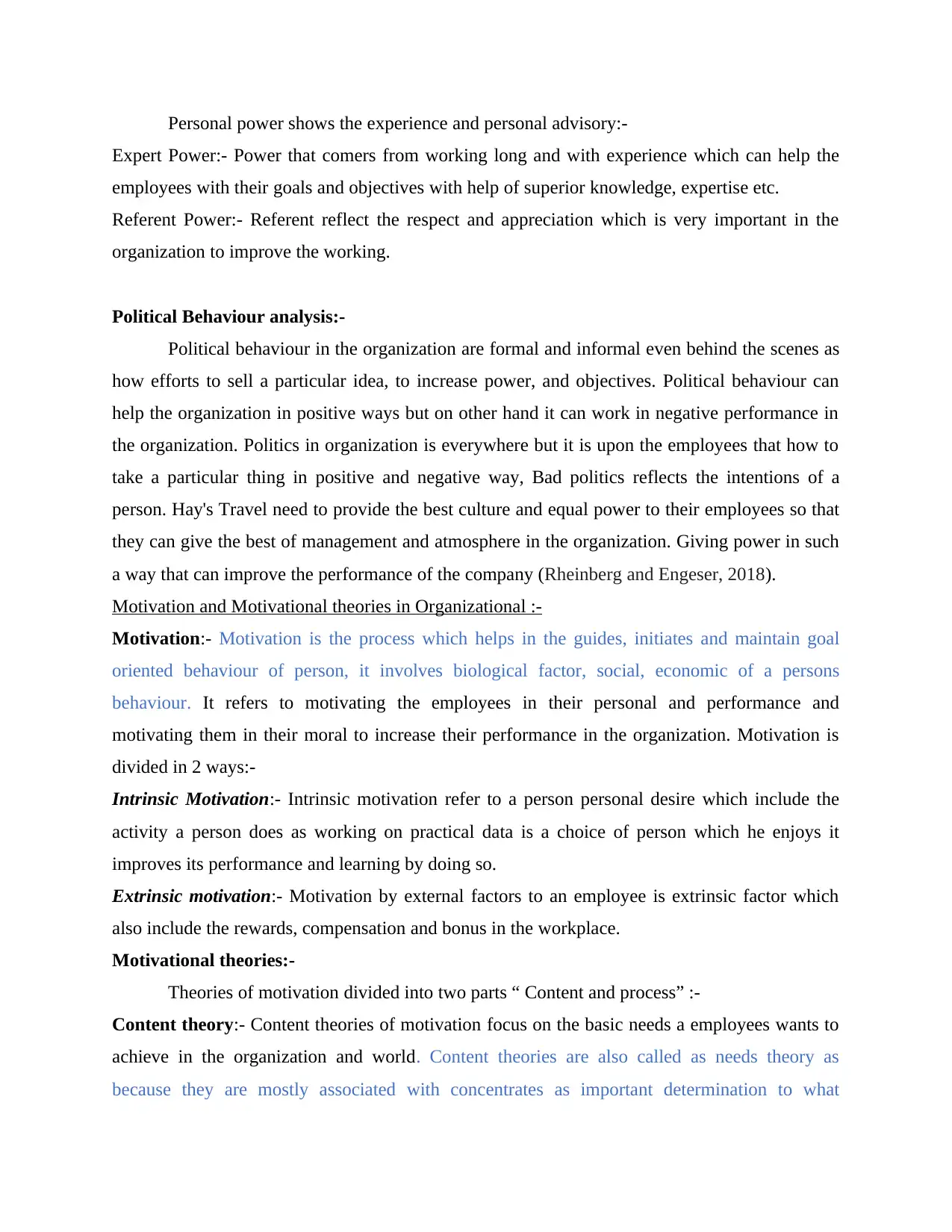
Personal power shows the experience and personal advisory:-
Expert Power:- Power that comers from working long and with experience which can help the
employees with their goals and objectives with help of superior knowledge, expertise etc.
Referent Power:- Referent reflect the respect and appreciation which is very important in the
organization to improve the working.
Political Behaviour analysis:-
Political behaviour in the organization are formal and informal even behind the scenes as
how efforts to sell a particular idea, to increase power, and objectives. Political behaviour can
help the organization in positive ways but on other hand it can work in negative performance in
the organization. Politics in organization is everywhere but it is upon the employees that how to
take a particular thing in positive and negative way, Bad politics reflects the intentions of a
person. Hay's Travel need to provide the best culture and equal power to their employees so that
they can give the best of management and atmosphere in the organization. Giving power in such
a way that can improve the performance of the company (Rheinberg and Engeser, 2018).
Motivation and Motivational theories in Organizational :-
Motivation:- Motivation is the process which helps in the guides, initiates and maintain goal
oriented behaviour of person, it involves biological factor, social, economic of a persons
behaviour. It refers to motivating the employees in their personal and performance and
motivating them in their moral to increase their performance in the organization. Motivation is
divided in 2 ways:-
Intrinsic Motivation:- Intrinsic motivation refer to a person personal desire which include the
activity a person does as working on practical data is a choice of person which he enjoys it
improves its performance and learning by doing so.
Extrinsic motivation:- Motivation by external factors to an employee is extrinsic factor which
also include the rewards, compensation and bonus in the workplace.
Motivational theories:-
Theories of motivation divided into two parts “ Content and process” :-
Content theory:- Content theories of motivation focus on the basic needs a employees wants to
achieve in the organization and world. Content theories are also called as needs theory as
because they are mostly associated with concentrates as important determination to what
Expert Power:- Power that comers from working long and with experience which can help the
employees with their goals and objectives with help of superior knowledge, expertise etc.
Referent Power:- Referent reflect the respect and appreciation which is very important in the
organization to improve the working.
Political Behaviour analysis:-
Political behaviour in the organization are formal and informal even behind the scenes as
how efforts to sell a particular idea, to increase power, and objectives. Political behaviour can
help the organization in positive ways but on other hand it can work in negative performance in
the organization. Politics in organization is everywhere but it is upon the employees that how to
take a particular thing in positive and negative way, Bad politics reflects the intentions of a
person. Hay's Travel need to provide the best culture and equal power to their employees so that
they can give the best of management and atmosphere in the organization. Giving power in such
a way that can improve the performance of the company (Rheinberg and Engeser, 2018).
Motivation and Motivational theories in Organizational :-
Motivation:- Motivation is the process which helps in the guides, initiates and maintain goal
oriented behaviour of person, it involves biological factor, social, economic of a persons
behaviour. It refers to motivating the employees in their personal and performance and
motivating them in their moral to increase their performance in the organization. Motivation is
divided in 2 ways:-
Intrinsic Motivation:- Intrinsic motivation refer to a person personal desire which include the
activity a person does as working on practical data is a choice of person which he enjoys it
improves its performance and learning by doing so.
Extrinsic motivation:- Motivation by external factors to an employee is extrinsic factor which
also include the rewards, compensation and bonus in the workplace.
Motivational theories:-
Theories of motivation divided into two parts “ Content and process” :-
Content theory:- Content theories of motivation focus on the basic needs a employees wants to
achieve in the organization and world. Content theories are also called as needs theory as
because they are mostly associated with concentrates as important determination to what
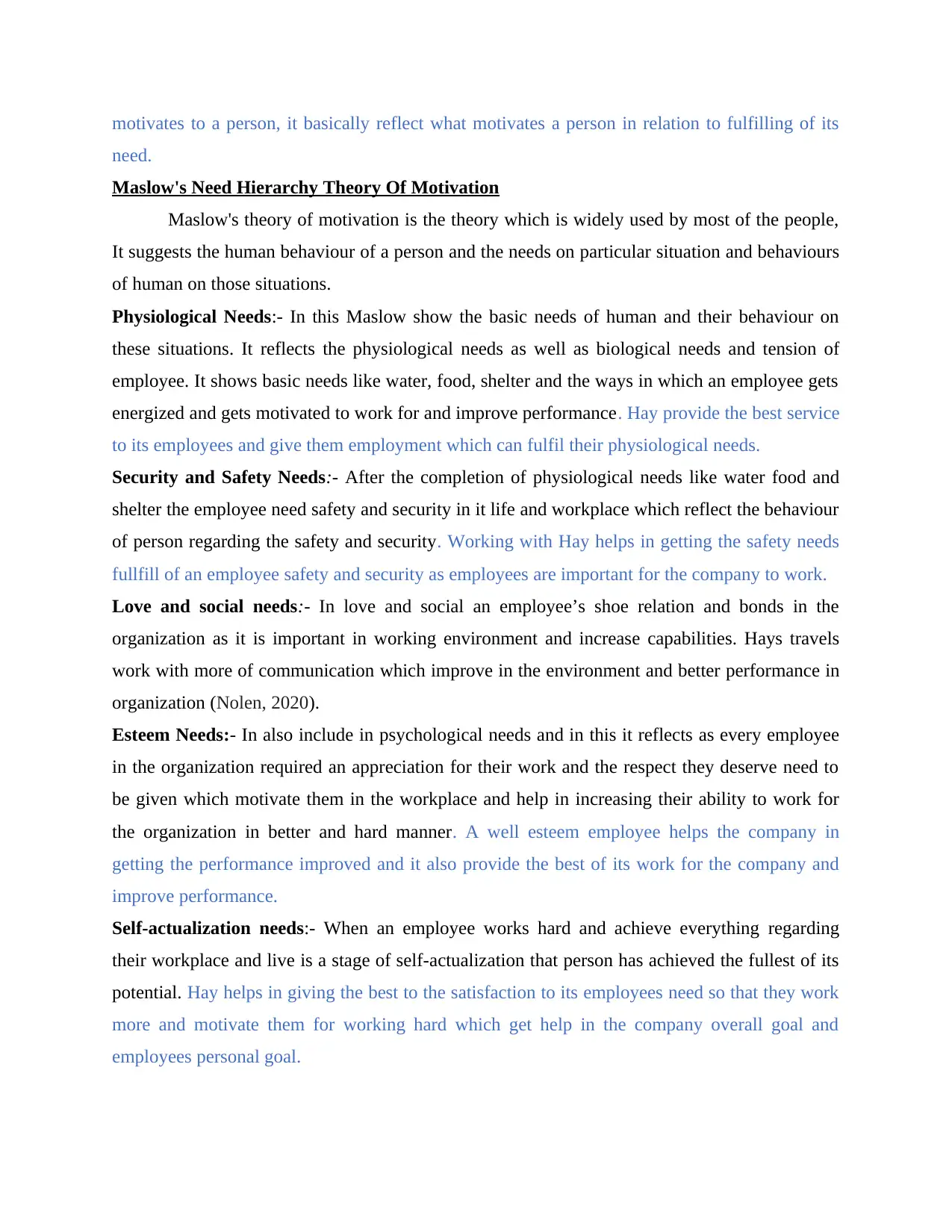
motivates to a person, it basically reflect what motivates a person in relation to fulfilling of its
need.
Maslow's Need Hierarchy Theory Of Motivation
Maslow's theory of motivation is the theory which is widely used by most of the people,
It suggests the human behaviour of a person and the needs on particular situation and behaviours
of human on those situations.
Physiological Needs:- In this Maslow show the basic needs of human and their behaviour on
these situations. It reflects the physiological needs as well as biological needs and tension of
employee. It shows basic needs like water, food, shelter and the ways in which an employee gets
energized and gets motivated to work for and improve performance. Hay provide the best service
to its employees and give them employment which can fulfil their physiological needs.
Security and Safety Needs:- After the completion of physiological needs like water food and
shelter the employee need safety and security in it life and workplace which reflect the behaviour
of person regarding the safety and security. Working with Hay helps in getting the safety needs
fullfill of an employee safety and security as employees are important for the company to work.
Love and social needs:- In love and social an employee’s shoe relation and bonds in the
organization as it is important in working environment and increase capabilities. Hays travels
work with more of communication which improve in the environment and better performance in
organization (Nolen, 2020).
Esteem Needs:- In also include in psychological needs and in this it reflects as every employee
in the organization required an appreciation for their work and the respect they deserve need to
be given which motivate them in the workplace and help in increasing their ability to work for
the organization in better and hard manner. A well esteem employee helps the company in
getting the performance improved and it also provide the best of its work for the company and
improve performance.
Self-actualization needs:- When an employee works hard and achieve everything regarding
their workplace and live is a stage of self-actualization that person has achieved the fullest of its
potential. Hay helps in giving the best to the satisfaction to its employees need so that they work
more and motivate them for working hard which get help in the company overall goal and
employees personal goal.
need.
Maslow's Need Hierarchy Theory Of Motivation
Maslow's theory of motivation is the theory which is widely used by most of the people,
It suggests the human behaviour of a person and the needs on particular situation and behaviours
of human on those situations.
Physiological Needs:- In this Maslow show the basic needs of human and their behaviour on
these situations. It reflects the physiological needs as well as biological needs and tension of
employee. It shows basic needs like water, food, shelter and the ways in which an employee gets
energized and gets motivated to work for and improve performance. Hay provide the best service
to its employees and give them employment which can fulfil their physiological needs.
Security and Safety Needs:- After the completion of physiological needs like water food and
shelter the employee need safety and security in it life and workplace which reflect the behaviour
of person regarding the safety and security. Working with Hay helps in getting the safety needs
fullfill of an employee safety and security as employees are important for the company to work.
Love and social needs:- In love and social an employee’s shoe relation and bonds in the
organization as it is important in working environment and increase capabilities. Hays travels
work with more of communication which improve in the environment and better performance in
organization (Nolen, 2020).
Esteem Needs:- In also include in psychological needs and in this it reflects as every employee
in the organization required an appreciation for their work and the respect they deserve need to
be given which motivate them in the workplace and help in increasing their ability to work for
the organization in better and hard manner. A well esteem employee helps the company in
getting the performance improved and it also provide the best of its work for the company and
improve performance.
Self-actualization needs:- When an employee works hard and achieve everything regarding
their workplace and live is a stage of self-actualization that person has achieved the fullest of its
potential. Hay helps in giving the best to the satisfaction to its employees need so that they work
more and motivate them for working hard which get help in the company overall goal and
employees personal goal.
⊘ This is a preview!⊘
Do you want full access?
Subscribe today to unlock all pages.

Trusted by 1+ million students worldwide
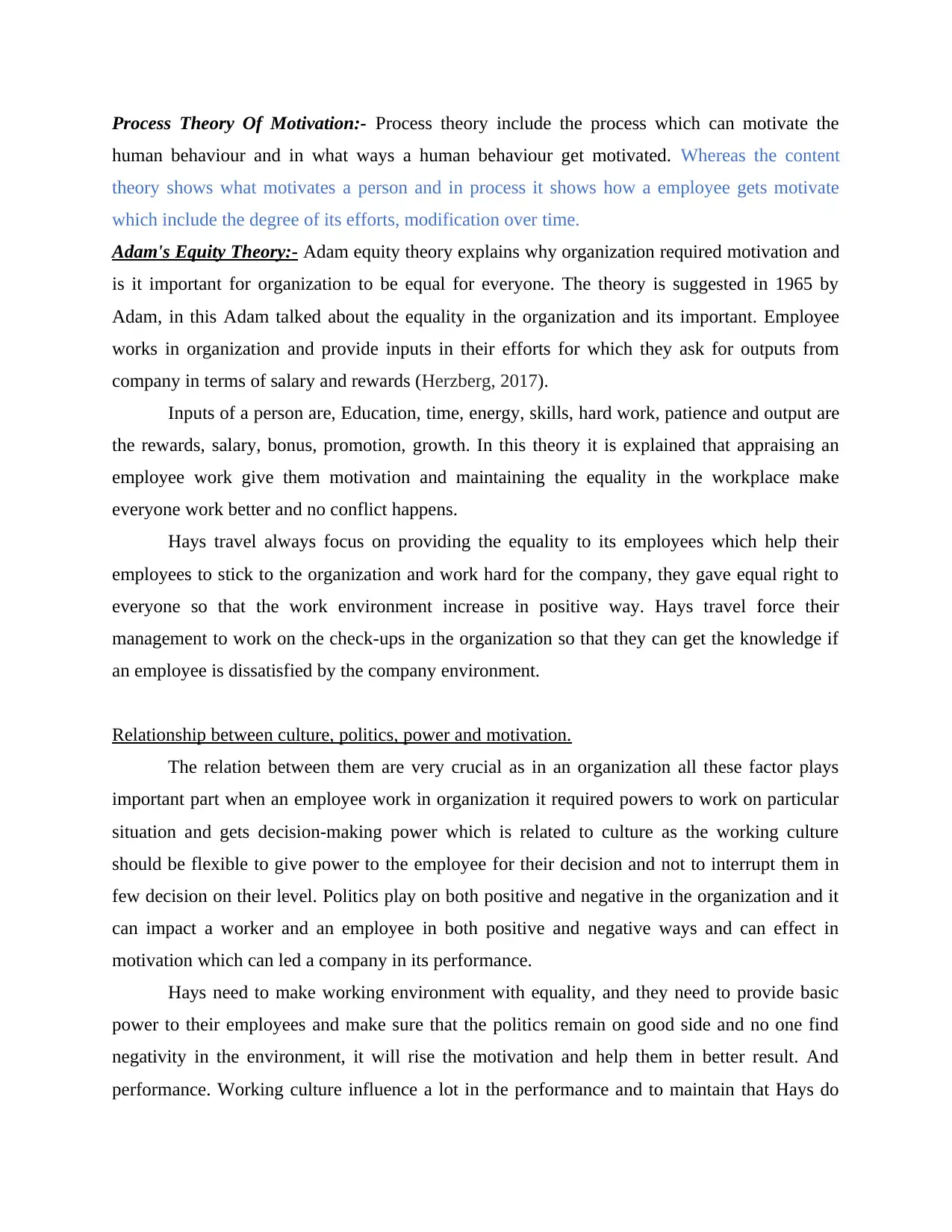
Process Theory Of Motivation:- Process theory include the process which can motivate the
human behaviour and in what ways a human behaviour get motivated. Whereas the content
theory shows what motivates a person and in process it shows how a employee gets motivate
which include the degree of its efforts, modification over time.
Adam's Equity Theory:- Adam equity theory explains why organization required motivation and
is it important for organization to be equal for everyone. The theory is suggested in 1965 by
Adam, in this Adam talked about the equality in the organization and its important. Employee
works in organization and provide inputs in their efforts for which they ask for outputs from
company in terms of salary and rewards (Herzberg, 2017).
Inputs of a person are, Education, time, energy, skills, hard work, patience and output are
the rewards, salary, bonus, promotion, growth. In this theory it is explained that appraising an
employee work give them motivation and maintaining the equality in the workplace make
everyone work better and no conflict happens.
Hays travel always focus on providing the equality to its employees which help their
employees to stick to the organization and work hard for the company, they gave equal right to
everyone so that the work environment increase in positive way. Hays travel force their
management to work on the check-ups in the organization so that they can get the knowledge if
an employee is dissatisfied by the company environment.
Relationship between culture, politics, power and motivation.
The relation between them are very crucial as in an organization all these factor plays
important part when an employee work in organization it required powers to work on particular
situation and gets decision-making power which is related to culture as the working culture
should be flexible to give power to the employee for their decision and not to interrupt them in
few decision on their level. Politics play on both positive and negative in the organization and it
can impact a worker and an employee in both positive and negative ways and can effect in
motivation which can led a company in its performance.
Hays need to make working environment with equality, and they need to provide basic
power to their employees and make sure that the politics remain on good side and no one find
negativity in the environment, it will rise the motivation and help them in better result. And
performance. Working culture influence a lot in the performance and to maintain that Hays do
human behaviour and in what ways a human behaviour get motivated. Whereas the content
theory shows what motivates a person and in process it shows how a employee gets motivate
which include the degree of its efforts, modification over time.
Adam's Equity Theory:- Adam equity theory explains why organization required motivation and
is it important for organization to be equal for everyone. The theory is suggested in 1965 by
Adam, in this Adam talked about the equality in the organization and its important. Employee
works in organization and provide inputs in their efforts for which they ask for outputs from
company in terms of salary and rewards (Herzberg, 2017).
Inputs of a person are, Education, time, energy, skills, hard work, patience and output are
the rewards, salary, bonus, promotion, growth. In this theory it is explained that appraising an
employee work give them motivation and maintaining the equality in the workplace make
everyone work better and no conflict happens.
Hays travel always focus on providing the equality to its employees which help their
employees to stick to the organization and work hard for the company, they gave equal right to
everyone so that the work environment increase in positive way. Hays travel force their
management to work on the check-ups in the organization so that they can get the knowledge if
an employee is dissatisfied by the company environment.
Relationship between culture, politics, power and motivation.
The relation between them are very crucial as in an organization all these factor plays
important part when an employee work in organization it required powers to work on particular
situation and gets decision-making power which is related to culture as the working culture
should be flexible to give power to the employee for their decision and not to interrupt them in
few decision on their level. Politics play on both positive and negative in the organization and it
can impact a worker and an employee in both positive and negative ways and can effect in
motivation which can led a company in its performance.
Hays need to make working environment with equality, and they need to provide basic
power to their employees and make sure that the politics remain on good side and no one find
negativity in the environment, it will rise the motivation and help them in better result. And
performance. Working culture influence a lot in the performance and to maintain that Hays do
Paraphrase This Document
Need a fresh take? Get an instant paraphrase of this document with our AI Paraphraser
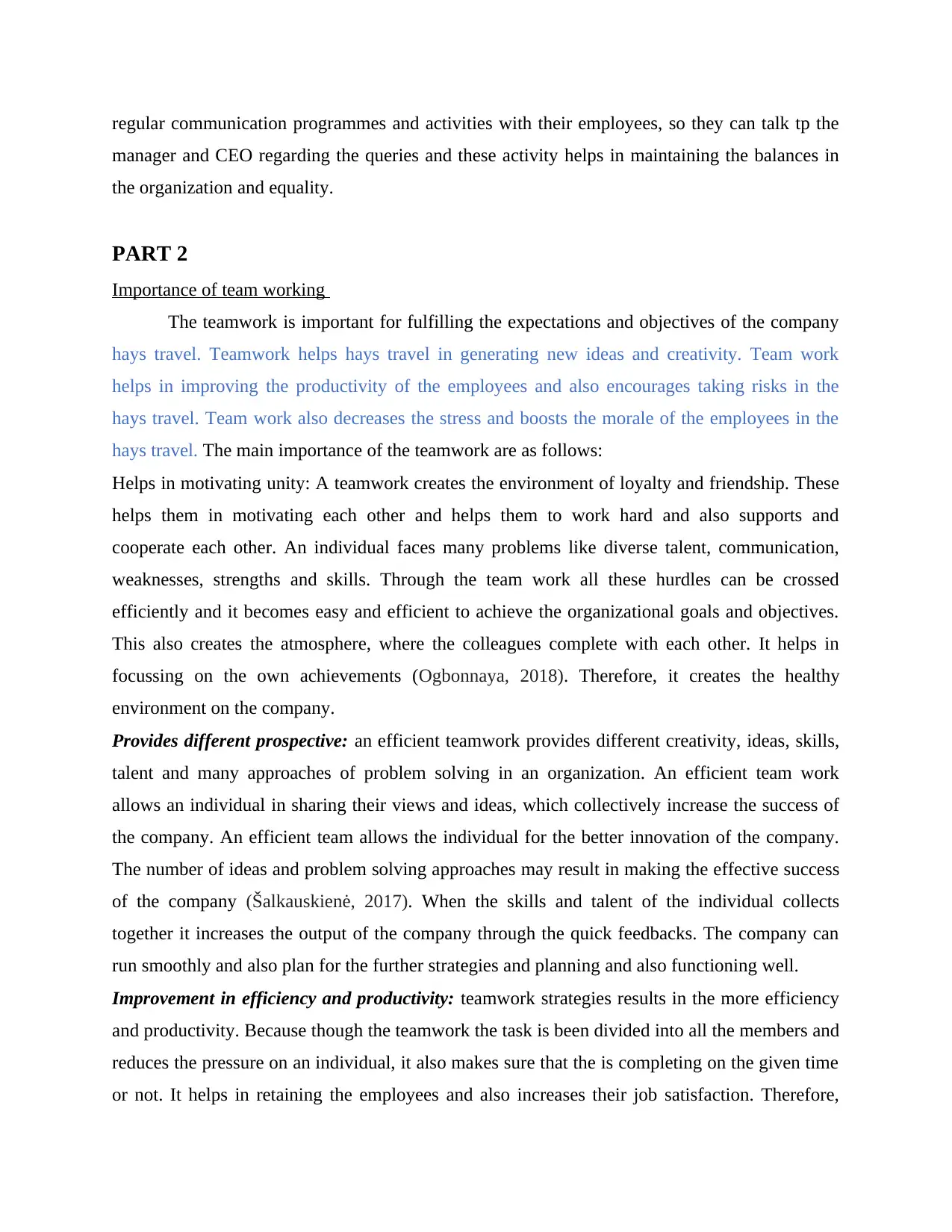
regular communication programmes and activities with their employees, so they can talk tp the
manager and CEO regarding the queries and these activity helps in maintaining the balances in
the organization and equality.
PART 2
Importance of team working
The teamwork is important for fulfilling the expectations and objectives of the company
hays travel. Teamwork helps hays travel in generating new ideas and creativity. Team work
helps in improving the productivity of the employees and also encourages taking risks in the
hays travel. Team work also decreases the stress and boosts the morale of the employees in the
hays travel. The main importance of the teamwork are as follows:
Helps in motivating unity: A teamwork creates the environment of loyalty and friendship. These
helps them in motivating each other and helps them to work hard and also supports and
cooperate each other. An individual faces many problems like diverse talent, communication,
weaknesses, strengths and skills. Through the team work all these hurdles can be crossed
efficiently and it becomes easy and efficient to achieve the organizational goals and objectives.
This also creates the atmosphere, where the colleagues complete with each other. It helps in
focussing on the own achievements (Ogbonnaya, 2018). Therefore, it creates the healthy
environment on the company.
Provides different prospective: an efficient teamwork provides different creativity, ideas, skills,
talent and many approaches of problem solving in an organization. An efficient team work
allows an individual in sharing their views and ideas, which collectively increase the success of
the company. An efficient team allows the individual for the better innovation of the company.
The number of ideas and problem solving approaches may result in making the effective success
of the company (Šalkauskienė, 2017). When the skills and talent of the individual collects
together it increases the output of the company through the quick feedbacks. The company can
run smoothly and also plan for the further strategies and planning and also functioning well.
Improvement in efficiency and productivity: teamwork strategies results in the more efficiency
and productivity. Because though the teamwork the task is been divided into all the members and
reduces the pressure on an individual, it also makes sure that the is completing on the given time
or not. It helps in retaining the employees and also increases their job satisfaction. Therefore,
manager and CEO regarding the queries and these activity helps in maintaining the balances in
the organization and equality.
PART 2
Importance of team working
The teamwork is important for fulfilling the expectations and objectives of the company
hays travel. Teamwork helps hays travel in generating new ideas and creativity. Team work
helps in improving the productivity of the employees and also encourages taking risks in the
hays travel. Team work also decreases the stress and boosts the morale of the employees in the
hays travel. The main importance of the teamwork are as follows:
Helps in motivating unity: A teamwork creates the environment of loyalty and friendship. These
helps them in motivating each other and helps them to work hard and also supports and
cooperate each other. An individual faces many problems like diverse talent, communication,
weaknesses, strengths and skills. Through the team work all these hurdles can be crossed
efficiently and it becomes easy and efficient to achieve the organizational goals and objectives.
This also creates the atmosphere, where the colleagues complete with each other. It helps in
focussing on the own achievements (Ogbonnaya, 2018). Therefore, it creates the healthy
environment on the company.
Provides different prospective: an efficient teamwork provides different creativity, ideas, skills,
talent and many approaches of problem solving in an organization. An efficient team work
allows an individual in sharing their views and ideas, which collectively increase the success of
the company. An efficient team allows the individual for the better innovation of the company.
The number of ideas and problem solving approaches may result in making the effective success
of the company (Šalkauskienė, 2017). When the skills and talent of the individual collects
together it increases the output of the company through the quick feedbacks. The company can
run smoothly and also plan for the further strategies and planning and also functioning well.
Improvement in efficiency and productivity: teamwork strategies results in the more efficiency
and productivity. Because though the teamwork the task is been divided into all the members and
reduces the pressure on an individual, it also makes sure that the is completing on the given time
or not. It helps in retaining the employees and also increases their job satisfaction. Therefore,
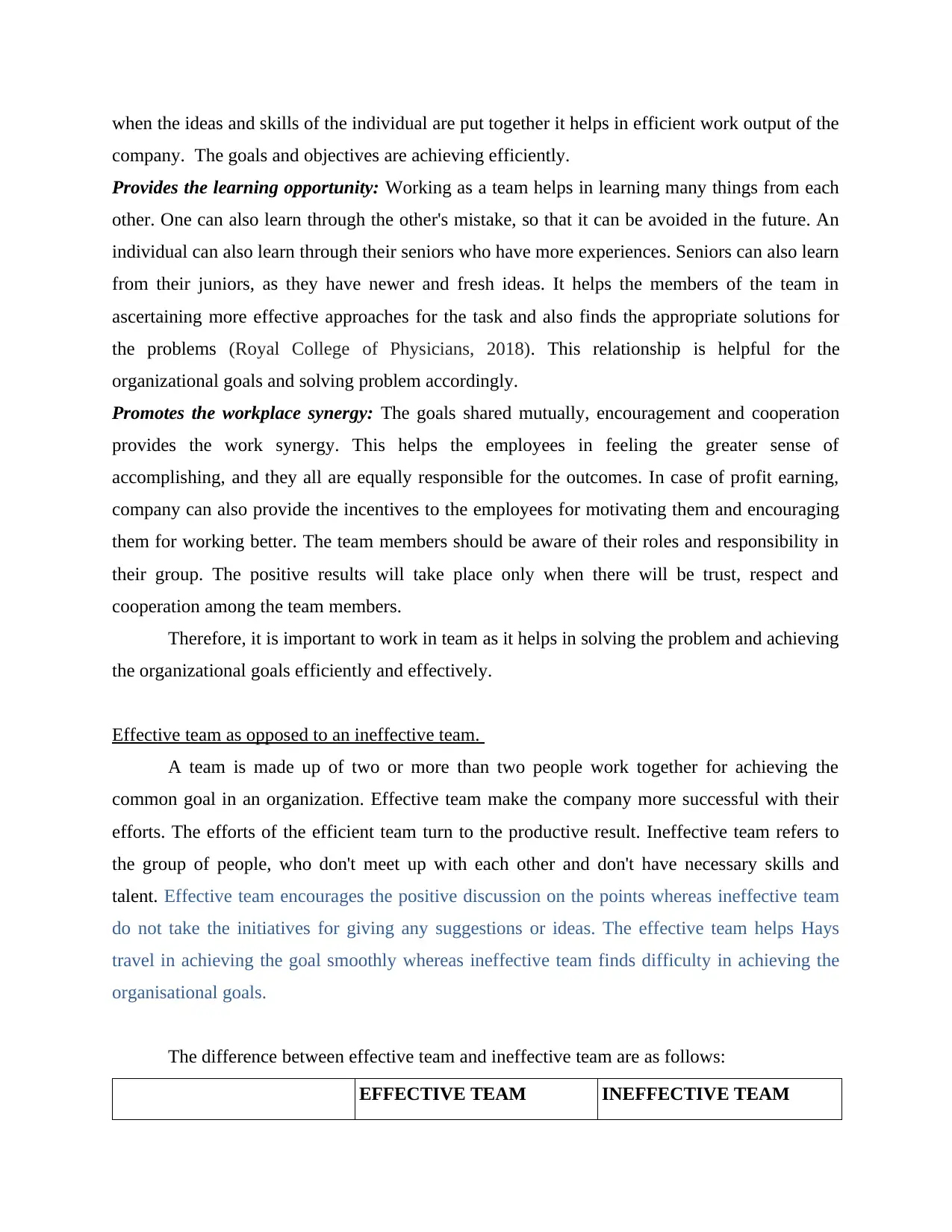
when the ideas and skills of the individual are put together it helps in efficient work output of the
company. The goals and objectives are achieving efficiently.
Provides the learning opportunity: Working as a team helps in learning many things from each
other. One can also learn through the other's mistake, so that it can be avoided in the future. An
individual can also learn through their seniors who have more experiences. Seniors can also learn
from their juniors, as they have newer and fresh ideas. It helps the members of the team in
ascertaining more effective approaches for the task and also finds the appropriate solutions for
the problems (Royal College of Physicians, 2018). This relationship is helpful for the
organizational goals and solving problem accordingly.
Promotes the workplace synergy: The goals shared mutually, encouragement and cooperation
provides the work synergy. This helps the employees in feeling the greater sense of
accomplishing, and they all are equally responsible for the outcomes. In case of profit earning,
company can also provide the incentives to the employees for motivating them and encouraging
them for working better. The team members should be aware of their roles and responsibility in
their group. The positive results will take place only when there will be trust, respect and
cooperation among the team members.
Therefore, it is important to work in team as it helps in solving the problem and achieving
the organizational goals efficiently and effectively.
Effective team as opposed to an ineffective team.
A team is made up of two or more than two people work together for achieving the
common goal in an organization. Effective team make the company more successful with their
efforts. The efforts of the efficient team turn to the productive result. Ineffective team refers to
the group of people, who don't meet up with each other and don't have necessary skills and
talent. Effective team encourages the positive discussion on the points whereas ineffective team
do not take the initiatives for giving any suggestions or ideas. The effective team helps Hays
travel in achieving the goal smoothly whereas ineffective team finds difficulty in achieving the
organisational goals.
The difference between effective team and ineffective team are as follows:
EFFECTIVE TEAM INEFFECTIVE TEAM
company. The goals and objectives are achieving efficiently.
Provides the learning opportunity: Working as a team helps in learning many things from each
other. One can also learn through the other's mistake, so that it can be avoided in the future. An
individual can also learn through their seniors who have more experiences. Seniors can also learn
from their juniors, as they have newer and fresh ideas. It helps the members of the team in
ascertaining more effective approaches for the task and also finds the appropriate solutions for
the problems (Royal College of Physicians, 2018). This relationship is helpful for the
organizational goals and solving problem accordingly.
Promotes the workplace synergy: The goals shared mutually, encouragement and cooperation
provides the work synergy. This helps the employees in feeling the greater sense of
accomplishing, and they all are equally responsible for the outcomes. In case of profit earning,
company can also provide the incentives to the employees for motivating them and encouraging
them for working better. The team members should be aware of their roles and responsibility in
their group. The positive results will take place only when there will be trust, respect and
cooperation among the team members.
Therefore, it is important to work in team as it helps in solving the problem and achieving
the organizational goals efficiently and effectively.
Effective team as opposed to an ineffective team.
A team is made up of two or more than two people work together for achieving the
common goal in an organization. Effective team make the company more successful with their
efforts. The efforts of the efficient team turn to the productive result. Ineffective team refers to
the group of people, who don't meet up with each other and don't have necessary skills and
talent. Effective team encourages the positive discussion on the points whereas ineffective team
do not take the initiatives for giving any suggestions or ideas. The effective team helps Hays
travel in achieving the goal smoothly whereas ineffective team finds difficulty in achieving the
organisational goals.
The difference between effective team and ineffective team are as follows:
EFFECTIVE TEAM INEFFECTIVE TEAM
⊘ This is a preview!⊘
Do you want full access?
Subscribe today to unlock all pages.

Trusted by 1+ million students worldwide
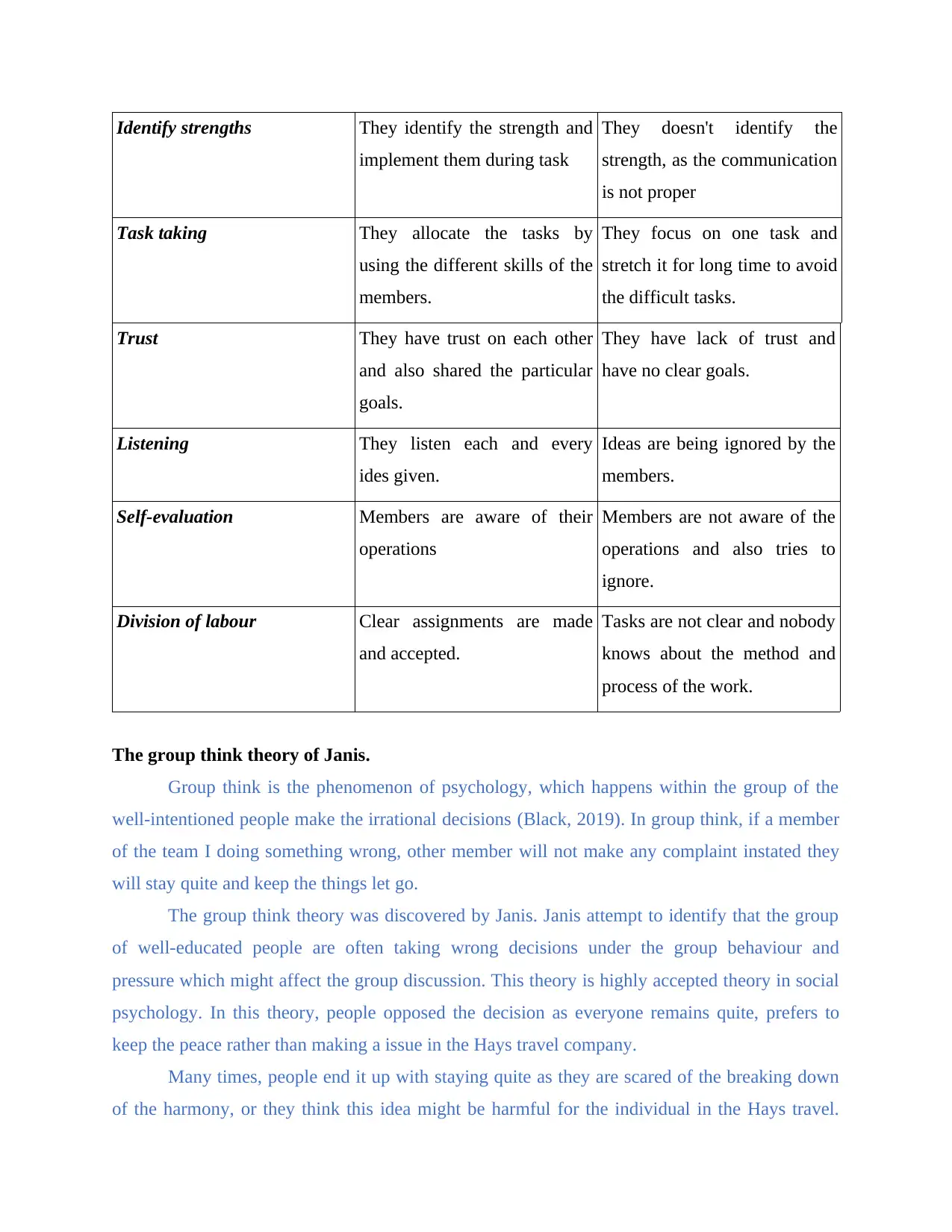
Identify strengths They identify the strength and
implement them during task
They doesn't identify the
strength, as the communication
is not proper
Task taking They allocate the tasks by
using the different skills of the
members.
They focus on one task and
stretch it for long time to avoid
the difficult tasks.
Trust They have trust on each other
and also shared the particular
goals.
They have lack of trust and
have no clear goals.
Listening They listen each and every
ides given.
Ideas are being ignored by the
members.
Self-evaluation Members are aware of their
operations
Members are not aware of the
operations and also tries to
ignore.
Division of labour Clear assignments are made
and accepted.
Tasks are not clear and nobody
knows about the method and
process of the work.
The group think theory of Janis.
Group think is the phenomenon of psychology, which happens within the group of the
well-intentioned people make the irrational decisions (Black, 2019). In group think, if a member
of the team I doing something wrong, other member will not make any complaint instated they
will stay quite and keep the things let go.
The group think theory was discovered by Janis. Janis attempt to identify that the group
of well-educated people are often taking wrong decisions under the group behaviour and
pressure which might affect the group discussion. This theory is highly accepted theory in social
psychology. In this theory, people opposed the decision as everyone remains quite, prefers to
keep the peace rather than making a issue in the Hays travel company.
Many times, people end it up with staying quite as they are scared of the breaking down
of the harmony, or they think this idea might be harmful for the individual in the Hays travel.
implement them during task
They doesn't identify the
strength, as the communication
is not proper
Task taking They allocate the tasks by
using the different skills of the
members.
They focus on one task and
stretch it for long time to avoid
the difficult tasks.
Trust They have trust on each other
and also shared the particular
goals.
They have lack of trust and
have no clear goals.
Listening They listen each and every
ides given.
Ideas are being ignored by the
members.
Self-evaluation Members are aware of their
operations
Members are not aware of the
operations and also tries to
ignore.
Division of labour Clear assignments are made
and accepted.
Tasks are not clear and nobody
knows about the method and
process of the work.
The group think theory of Janis.
Group think is the phenomenon of psychology, which happens within the group of the
well-intentioned people make the irrational decisions (Black, 2019). In group think, if a member
of the team I doing something wrong, other member will not make any complaint instated they
will stay quite and keep the things let go.
The group think theory was discovered by Janis. Janis attempt to identify that the group
of well-educated people are often taking wrong decisions under the group behaviour and
pressure which might affect the group discussion. This theory is highly accepted theory in social
psychology. In this theory, people opposed the decision as everyone remains quite, prefers to
keep the peace rather than making a issue in the Hays travel company.
Many times, people end it up with staying quite as they are scared of the breaking down
of the harmony, or they think this idea might be harmful for the individual in the Hays travel.
Paraphrase This Document
Need a fresh take? Get an instant paraphrase of this document with our AI Paraphraser
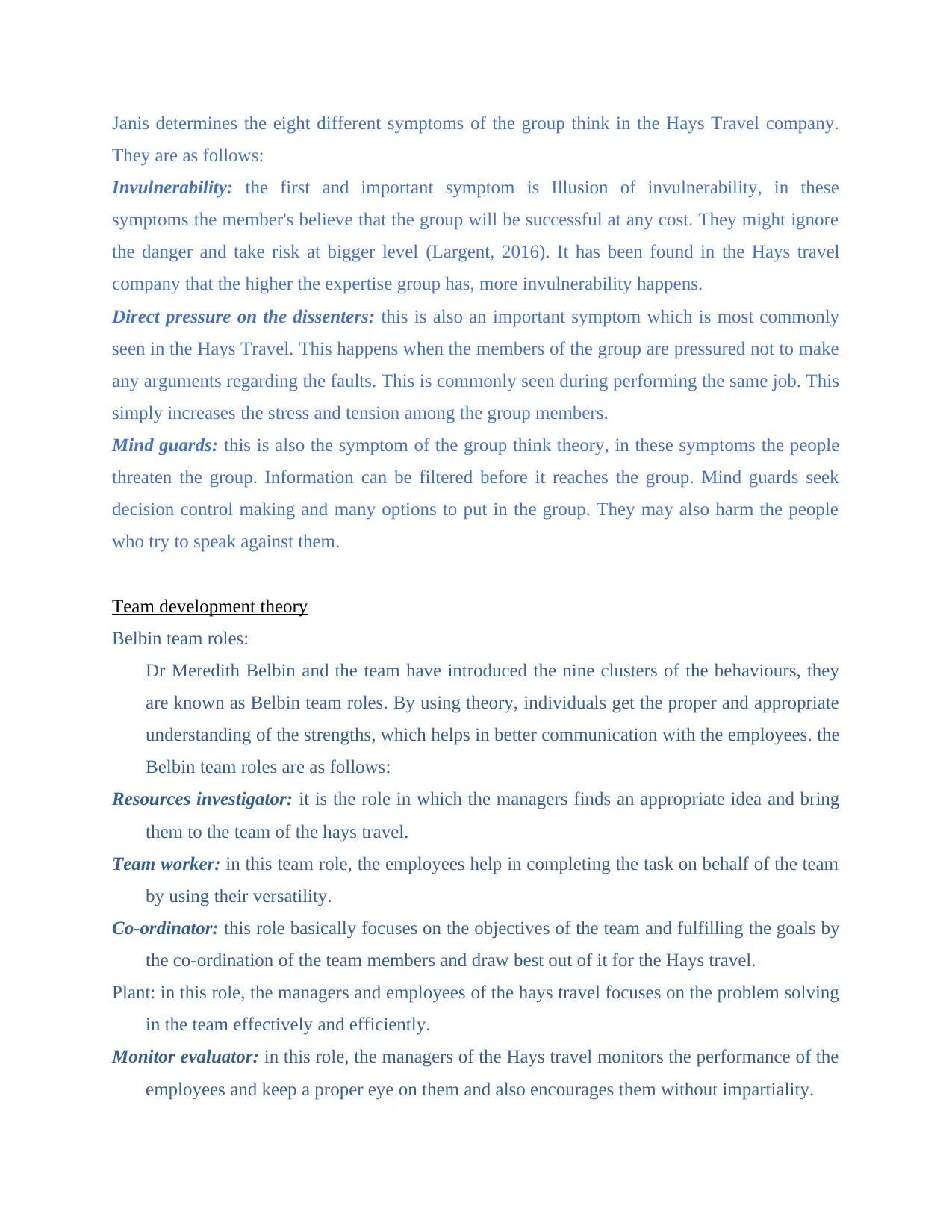
Janis determines the eight different symptoms of the group think in the Hays Travel company.
They are as follows:
Invulnerability: the first and important symptom is Illusion of invulnerability, in these
symptoms the member's believe that the group will be successful at any cost. They might ignore
the danger and take risk at bigger level (Largent, 2016). It has been found in the Hays travel
company that the higher the expertise group has, more invulnerability happens.
Direct pressure on the dissenters: this is also an important symptom which is most commonly
seen in the Hays Travel. This happens when the members of the group are pressured not to make
any arguments regarding the faults. This is commonly seen during performing the same job. This
simply increases the stress and tension among the group members.
Mind guards: this is also the symptom of the group think theory, in these symptoms the people
threaten the group. Information can be filtered before it reaches the group. Mind guards seek
decision control making and many options to put in the group. They may also harm the people
who try to speak against them.
Team development theory
Belbin team roles:
Dr Meredith Belbin and the team have introduced the nine clusters of the behaviours, they
are known as Belbin team roles. By using theory, individuals get the proper and appropriate
understanding of the strengths, which helps in better communication with the employees. the
Belbin team roles are as follows:
Resources investigator: it is the role in which the managers finds an appropriate idea and bring
them to the team of the hays travel.
Team worker: in this team role, the employees help in completing the task on behalf of the team
by using their versatility.
Co-ordinator: this role basically focuses on the objectives of the team and fulfilling the goals by
the co-ordination of the team members and draw best out of it for the Hays travel.
Plant: in this role, the managers and employees of the hays travel focuses on the problem solving
in the team effectively and efficiently.
Monitor evaluator: in this role, the managers of the Hays travel monitors the performance of the
employees and keep a proper eye on them and also encourages them without impartiality.
They are as follows:
Invulnerability: the first and important symptom is Illusion of invulnerability, in these
symptoms the member's believe that the group will be successful at any cost. They might ignore
the danger and take risk at bigger level (Largent, 2016). It has been found in the Hays travel
company that the higher the expertise group has, more invulnerability happens.
Direct pressure on the dissenters: this is also an important symptom which is most commonly
seen in the Hays Travel. This happens when the members of the group are pressured not to make
any arguments regarding the faults. This is commonly seen during performing the same job. This
simply increases the stress and tension among the group members.
Mind guards: this is also the symptom of the group think theory, in these symptoms the people
threaten the group. Information can be filtered before it reaches the group. Mind guards seek
decision control making and many options to put in the group. They may also harm the people
who try to speak against them.
Team development theory
Belbin team roles:
Dr Meredith Belbin and the team have introduced the nine clusters of the behaviours, they
are known as Belbin team roles. By using theory, individuals get the proper and appropriate
understanding of the strengths, which helps in better communication with the employees. the
Belbin team roles are as follows:
Resources investigator: it is the role in which the managers finds an appropriate idea and bring
them to the team of the hays travel.
Team worker: in this team role, the employees help in completing the task on behalf of the team
by using their versatility.
Co-ordinator: this role basically focuses on the objectives of the team and fulfilling the goals by
the co-ordination of the team members and draw best out of it for the Hays travel.
Plant: in this role, the managers and employees of the hays travel focuses on the problem solving
in the team effectively and efficiently.
Monitor evaluator: in this role, the managers of the Hays travel monitors the performance of the
employees and keep a proper eye on them and also encourages them without impartiality.
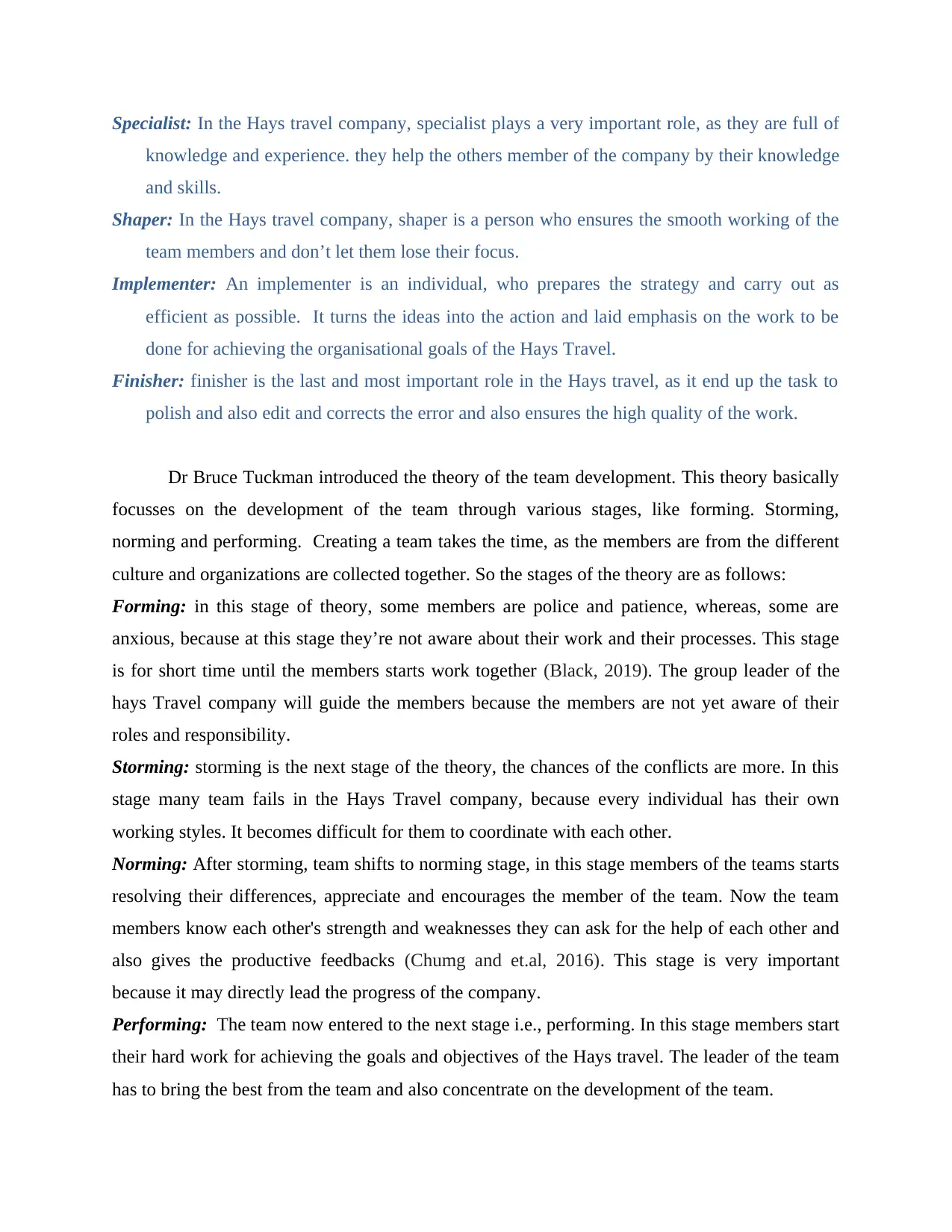
Specialist: In the Hays travel company, specialist plays a very important role, as they are full of
knowledge and experience. they help the others member of the company by their knowledge
and skills.
Shaper: In the Hays travel company, shaper is a person who ensures the smooth working of the
team members and don’t let them lose their focus.
Implementer: An implementer is an individual, who prepares the strategy and carry out as
efficient as possible. It turns the ideas into the action and laid emphasis on the work to be
done for achieving the organisational goals of the Hays Travel.
Finisher: finisher is the last and most important role in the Hays travel, as it end up the task to
polish and also edit and corrects the error and also ensures the high quality of the work.
Dr Bruce Tuckman introduced the theory of the team development. This theory basically
focusses on the development of the team through various stages, like forming. Storming,
norming and performing. Creating a team takes the time, as the members are from the different
culture and organizations are collected together. So the stages of the theory are as follows:
Forming: in this stage of theory, some members are police and patience, whereas, some are
anxious, because at this stage they’re not aware about their work and their processes. This stage
is for short time until the members starts work together (Black, 2019). The group leader of the
hays Travel company will guide the members because the members are not yet aware of their
roles and responsibility.
Storming: storming is the next stage of the theory, the chances of the conflicts are more. In this
stage many team fails in the Hays Travel company, because every individual has their own
working styles. It becomes difficult for them to coordinate with each other.
Norming: After storming, team shifts to norming stage, in this stage members of the teams starts
resolving their differences, appreciate and encourages the member of the team. Now the team
members know each other's strength and weaknesses they can ask for the help of each other and
also gives the productive feedbacks (Chumg and et.al, 2016). This stage is very important
because it may directly lead the progress of the company.
Performing: The team now entered to the next stage i.e., performing. In this stage members start
their hard work for achieving the goals and objectives of the Hays travel. The leader of the team
has to bring the best from the team and also concentrate on the development of the team.
knowledge and experience. they help the others member of the company by their knowledge
and skills.
Shaper: In the Hays travel company, shaper is a person who ensures the smooth working of the
team members and don’t let them lose their focus.
Implementer: An implementer is an individual, who prepares the strategy and carry out as
efficient as possible. It turns the ideas into the action and laid emphasis on the work to be
done for achieving the organisational goals of the Hays Travel.
Finisher: finisher is the last and most important role in the Hays travel, as it end up the task to
polish and also edit and corrects the error and also ensures the high quality of the work.
Dr Bruce Tuckman introduced the theory of the team development. This theory basically
focusses on the development of the team through various stages, like forming. Storming,
norming and performing. Creating a team takes the time, as the members are from the different
culture and organizations are collected together. So the stages of the theory are as follows:
Forming: in this stage of theory, some members are police and patience, whereas, some are
anxious, because at this stage they’re not aware about their work and their processes. This stage
is for short time until the members starts work together (Black, 2019). The group leader of the
hays Travel company will guide the members because the members are not yet aware of their
roles and responsibility.
Storming: storming is the next stage of the theory, the chances of the conflicts are more. In this
stage many team fails in the Hays Travel company, because every individual has their own
working styles. It becomes difficult for them to coordinate with each other.
Norming: After storming, team shifts to norming stage, in this stage members of the teams starts
resolving their differences, appreciate and encourages the member of the team. Now the team
members know each other's strength and weaknesses they can ask for the help of each other and
also gives the productive feedbacks (Chumg and et.al, 2016). This stage is very important
because it may directly lead the progress of the company.
Performing: The team now entered to the next stage i.e., performing. In this stage members start
their hard work for achieving the goals and objectives of the Hays travel. The leader of the team
has to bring the best from the team and also concentrate on the development of the team.
⊘ This is a preview!⊘
Do you want full access?
Subscribe today to unlock all pages.

Trusted by 1+ million students worldwide
1 out of 16
Related Documents
Your All-in-One AI-Powered Toolkit for Academic Success.
+13062052269
info@desklib.com
Available 24*7 on WhatsApp / Email
![[object Object]](/_next/static/media/star-bottom.7253800d.svg)
Unlock your academic potential
Copyright © 2020–2025 A2Z Services. All Rights Reserved. Developed and managed by ZUCOL.



